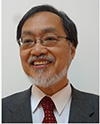Distinguished Lecturers
To request a Distinguished Lecturer (DL) for your next event, complete the DL Application Form. For more information or to see the full list, go to the Distinguished Lecturers page.

Japan
Toshio Fukuda received the B.S. degree in mechanical engineering from Waseda University, Tokyo, Japan, in 1971, and the M.S. and Ph.D. degrees in mechanical engineering from the University of Tokyo, Tokyo, in 1973 and 1977, respectively. From 1977 to 1982, he was in the National Mechanical Engineering Laboratory, Tsukuba, Japan. From 1982 to 1989, he was at the Science University of Tokyo, Tokyo. Starting in 1989, he was at Nagoya University, Nagoya, Japan, where he was a Professor in the Department of Micro System Engineering, and a Professor at Meijo University, Nagoya. He is currently a Professor (1000 Foreign experts Plan) with the Beijing Advanced Innovation Center for Intelligent Robots and Systems, Beijing Institute of Technology, Beijing, China, where he is mainly engaged in the research fields of intelligent robotic systems, cellular robotic systems, mechatronics, and micro/nano robotics.
Toshio Fukuda was the President of IEEE Robotics and Automation Society (1998–1999), the Editor-in Chief of the IEEE/ASME TRANSACTIONS ON MECHATRONICS (2000–2002), the Director of Division X: Systems and Control (2001–2002), the IEEE Founding President of the Nanotechnology Council (2002–2003, 2005), the Director of Region 10 (2013–2014), and the Director of Division X: Systems and Control (2017–2018) and Foreign member of Chinese Academy of Sciences (2017).
Talk # 1
Mutli-Scale Robotic System --- From large scale cellular robot to small scale robots
This lecture is an overview of the Multi-scale robotics, based on the Cellular Robotics System, which is the basic concept of the emergence of intelligence in the multi-scale way from Cell Level to the Organizational Level, proposed more than 30 years ago. It consists of many elements how the system can be structured from the individual to the group/society levels in analogy with the biological system. It covers with the wide range of challenging topics: Then I mainly focus on medical robots and bio cell manipulation and cell assembly and refer to applied areas for the future hybrid cyborg and bionic system to improve the quality of life of human.

Pisa, Italy
Arianna Menciassi is Full Professor of Biomedical Robotics at Scuola Superiore Sant’Anna (SSSA) and team leader of the “Surgical Robotics & Allied Technologies” Area at The BioRobotics Institute. She obtained the Master Degree in Physics (summa cum laude, 1995) at the Pisa University and the PhD in Bioengineering at SSSA (1999). She was Visiting Professor at the Ecole Nationale Superieure de Mecaniques et des Microtechniques of Besancon (France), and at the ISIR Institute at the Université Pierre et Marie Curie, in Paris. She has a substantial devotion to training and education, both at SSSA and at the University of Pisa, having served as preceptor to 15 postdoctoral associates, 20 PhD students and ~ 50 graduate degree recipients.
Her main research interests involve surgical robotics, biomedical robotics, microsystem technology and micromechatronics, with a special attention to the synergy between robot-assisted therapy and micro-nano-biotechnology-related solutions. She also focuses on magnetically-driven microrobots and microdevices, as well as on biomedical integrated platforms for magnetic navigation and ultrasound-based treatments. She carries on an important activity of scientific management of several projects European and extra-European, thus implying many collaborations abroad and an intense research activity. She is co-author of more than 370 scientific publications and 7 book chapters on biomedical robots/devices and microtechnology. She is co-Editor of a book on piezoelectric nanomaterials for biomedical applications. She is also inventor of 25 patents, national and international. She served until August 2013 in the Editorial Board of the IEEE-ASME Trans. on Mechatronics and she is now Topic Editor in Medical Robotics of the International Journal of Advanced Robotic Systems; she is Co-Chair of the IEEE Technical Committee on Surgical Robotics, she is in the Steering Committee of the Society for Medical Innovation and Technology and in the Steering Committee of the IEEE Transactions on Nanobioscience. In the year 2007, she received the Well-tech Award (Milan, Italy) for her researches on endoscopic capsules, and she was awarded by the Tuscany Region with the Gonfalone D’Argento, as one of the best 10 young talents of the region.
Talk # 1
Robotic technologies and micro-technologies for targeted therapy: challenge and opportunities
Robotic manipulators have been introduced for the first time in surgery in 1985, when a Puma 560 was used by Kwoh for performing neurosurgical biopsies with high precision. After that milestone, robots and robotic technologies have gained an increasingly important role in surgery, thanks to the accuracy and repeatability they could add to surgical tasks. From the original task of increasing accuracy and repeatability, robots today are asked to do more: they should be un-intrusive and flexible in terms of sharing control with human operators, they should perform better some tasks and they should reach areas normally not reachable by traditional surgical solutions. This talk introduces the key aspects of targeted therapy starting from the speaker experience on robotics for minimally invasive and computer assisted surgery. The quest for miniaturization and natural access to the targeted pathologies led to the development of diagnostic and surgical tools to be delivered with an endoluminal and transluminal approach - such as endoscopic capsules - and to be controlled and propelled by remote operation schemes from outside. In addition to the traditional control of remote devices into the body, external sources, such as magnetic fields, ultrasound waves or laser beams, have been used for stimulating internal devices and triggering some therapeutic effects from outside, in a non-invasive way. The quest for targeted therapy has recently opened new opportunities for robotic technologies, which are used more and more as controllers for the delivery of drugs embedded in nanobiotech vectors and as solutions for making therapy really localized in the area of interest, enabling on-demand release kinetics and eliminating (or strongly limiting) side effects. This talk aims to present the above mentioned trends, with the support of specific examples coming from the speaker experience and her collaboration network.